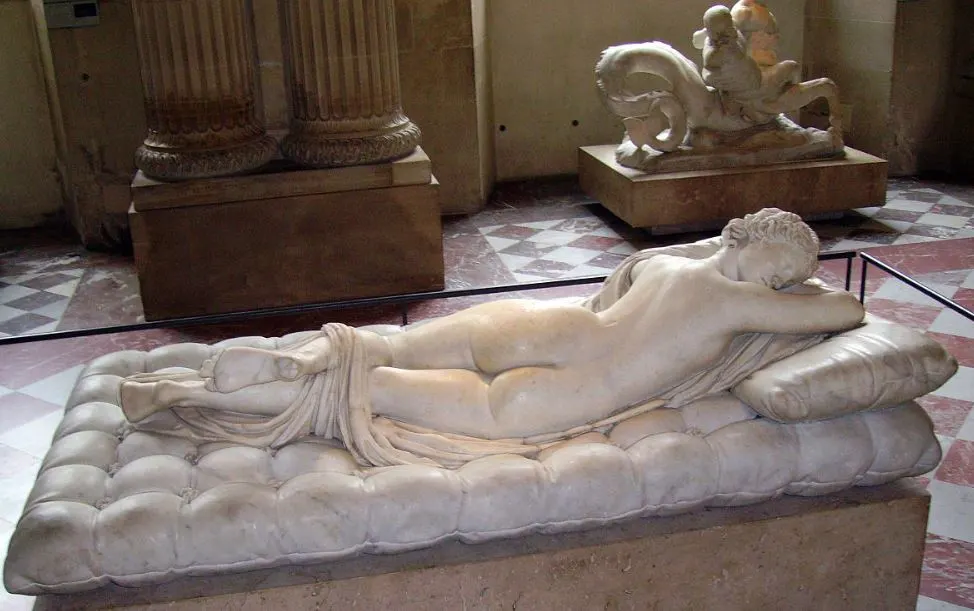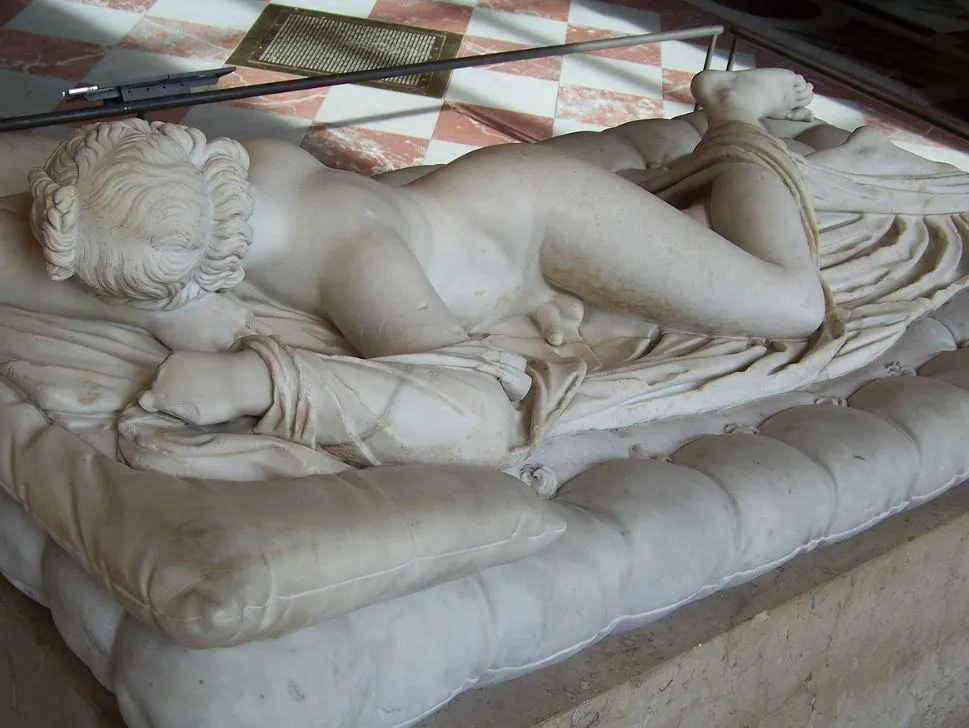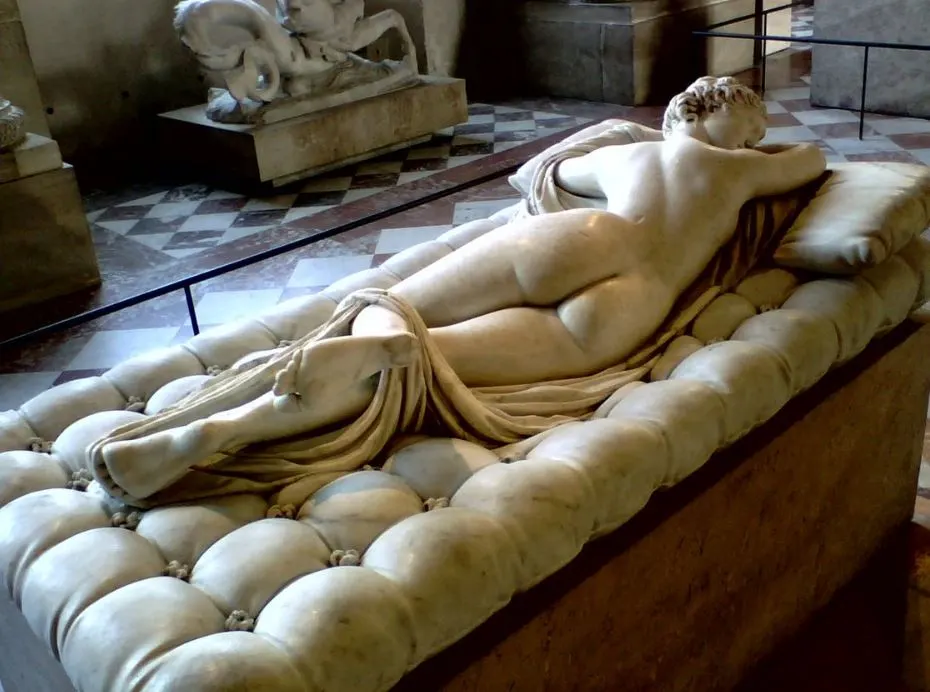The excavation works of a new church in Rome uncovered an ancient marble sculpture in the early 17th century.
The people who uncovered this marvelous work of art instantly knew they had hit the jackpot and it wasn’t long before a notorious Cardinal got word of it.
One of the most famous Baroque sculptors in history added a remarkable element to this ancient work so it’s petty much a dual work of art.
In this article, you’ll discover some of the most interesting facts about the Sleeping Hermaphroditus, one of the best-known sculptures at the Louvre.
1. It probably dates back to the early phase of the Roman Empire
The Sleeping Hermaphroditus is the name of an ancient sculpture that depicts Hermaphroditus, the child of Aphrodite and Hermes according to Greek mythology.
The sculpture has been described as a blend between portrayals of Venus and the feminized version of Dionysus, the god of wine.
The nude woman only has a sheet wrapped around the lower part of her legs and rests on her arms. This was a popular pose in ancient Greece and Rome.
Not just that, this particular figure from Greek mythology was one of the most popular figures in ancient art. Numerous ancient sculptures depicting the beautiful female have been unearthed.
Even though there is no contemporary documentation, it’s likely that it was sculpted during the early years of the Roman Empire in the late 1st century B.C. or early 1st century A.D.

2. It’s probably a copy of a much older Hellenistic bronze sculpture

Because the embodiment of Hermaphroditus was carved from marble so many times, it makes dating this magnificent work of art nearly impossible.
What we do know is that a similar bronze sculpture by the ancient Greek sculptor Polycles (active in the 150s B.C.) was completed well over a century earlier.
This bronze work of art has been lost to history but was mentioned in Pliny’s Natural History (Naturalis Historia). The first 10 books of this work were published in 77 A.D.

3. It was rediscovered during the groundbreaking of a Baroque church in Rome
Many ancient sculptures were uncovered during construction projects in modern times, including the Sleeping Hermaphroditus.
This happened shortly after excavation works were started at Santa Maria della Vittoria in 1608, a Baroque church located near the Baths of Diocletian.
This area was part of the Gardens of Sallust, an ancient pleasure garden that was founded by Historian Sallust in the 1st century B.C.
It’s likely that this beautiful sculpture once decorated a wonderful green space near the ancient city of Rome.

4. The sculpture was initially known as the “Borghese Hermaphroditus”
Santa Maria della Vittoria is a church located in the Rione Sallustiano in the northern part of the historical heart of Rome.
It’s located just near the immense Borghese Gardens and is best known for the famous sculpture by Bernini called “The Ecstasy of Saint Teresa.”
It wasn’t too long before Cardinal Scipione Borghese (1577-1633) came to take a look at this new discovery and the sculpture was soon hauled off to his opulent Villa Borghese.
In return, he promised to donate the façade of the church and kept his work, even though it was only completed about 16 years later.
He soon installed the Sleeping Hermaphroditus in a room specially designated to it and it came to be known as the Borghese Hermaphroditus shortly after.

5. The mattress on which the nude woman lies was sculpted in 1620
Gian Lorenzo Bernini (1598-1680) was one of the most renowned Baroque sculptors of the 17th century and defined Baroque sculpture during his time.
One of his most notable patrons was none other than Scipione Borghese, a man who made a fortune as the secretary of his uncle, Pope Paul V.
Upon discovery, the ancient sculpture didn’t feature the mattress and pillow it was lying on. The Cardinal commissioned Bernini to sculpt the buttoned mattress, a project he completed in 1620.
Bernini was still in his early twenties and was paid the handsome fee of 60 scudi (gold coins) for his service.

6. The sculpture was moved to the Louvre Museum in the early 19th century
The reason why it’s not referred to as the Borghese Hermaphroditus is that the original sculpture is not present at the Villa Borghese anymore.
It’s one of many artworks that were sold to the French state during the reign of Napoleon Bonaparte. The reason was the marriage between Prince Camillo Borghese and Pauline Bonaparte, Napoleon’s sister.
The French Emperor was able to snatch these works for a fraction of the price during this period and moved all of them to the Louvre Museum in Paris in the early 19th century.

7. How big is the Sleeping Hermaphroditus at the Louvre Museum?
The Sleeping Hermaphroditus depicts Hermaphroditus as life-sized, even though Bernini’s mattress makes it look quite a bit larger than it really is.
The length of this magnificent work of art is approximately 169 centimeters (67 inches).

8. There are several more ancient copies on display in popular museums
The most striking fact about this ancient sculpture is that several copies of this marble work of art have been uncovered.
The two most notable examples are located in Rome, one at the Borghese Gallery and one at the National Museum of Rome. The first is located in the same spot where the original was once placed.

Other copies can be found in several other museums, including the Uffizi Gallery in Florence, the Hermitage Museum in Saint Petersburg, and the Vatican Museums in Vatican City.

